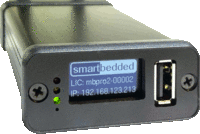Meteobridge NBIOT
What is NB-IOT good for
So far Meteobridges were relying on an Internet connection in order to send aquired weather data to external services. The need for an Internet connection does hurt in remote locations where no LAN/WLAN is available and setting up a mobile Internet access is too costly, too cumbersome or not possible because of weak mobile signal levels. To cope with situations like this many providers in Europe make use of an extension of the LTE/4G standard which also defines "Narrow Band - Internet of Things" transmissions which just allow for small data troughput but at much larger distances than mobile LTE/4G. These standard has been widely rolled out in many parts or Europe (Germany, Benelux, Austria, Switzerland, Italy) and 1NCE does provide SIM cards that have a prepaid data volume and life time of 10 years. During the last year we worked on making use of NBIOT as a plugin option for our Meteobridge PRO2 product line and we are now ready to launch.
Why no LaRaWAN?
LoRaWAN is very popular but despite also offering good connectivity in offsite locations it always needs a central gateway which acts like an access point that needs to be installed first and LoRaWAN devices connected to this gateway. The gateway needs access to the Internet by any of the classical ways. So you have to setup a LoRaWAN infrastrucure first, which the clients can share. We don't think that this is the simple solution we are looking for. NB-IOT lets the clients directly connect to the Internet, it does not need a setup of in-between gateways and infrastructure.
How to make use of NB-IOT data?
When the Meteobridge does send data via NB-IOT there needs to be a place where to drop this data and where the users can access the collected data. For Meteobridge we operate a server in the Internet, where the data is collected and you can pickup your data via simple HTTP GET requests. This service is free of charge. Instead of writing your own program to pickup data via a public available API from this server you can simply use a second Meteobridge at home (connected to the Internet) and select "NBIOT" as weather station. Now your Meteobridge at home is reading data the remote Meteobridge PRO2 NBIOT is sending. Voila!
NBIOT Restrictions
As the 1NCE data volume restriction for the 10 years of life time is 500 MB the Meteobridge can just report abt 30 sensors in 1 minute resolution and is based on massive compression. Furthermore the light weight UDP protocol is used, which is a "fire and forget" protocol where it is not checked if the data packet reaches the server. NBIOT takes care that the RF portion is done in hand shake, so no data is lost in the air. But data losses because it is lost somewhere in the Internet are not visible to the sender. We tested how big this "packets lost in the Internet" issue is and it turned out that 99% of packets are received fine. So gaps are really minor. An NBIOT connection can just transport compressed data of some sensors, it is not comparable to a true INternet connection. As a result you cannot reach the GUI via remote login, the Meteobridge cannot feed weather networks, it cannot send emails, it cannot do FTP uploads or http requests. It is fully isolated apart of being able to send selected data. But when you have another Meteobridge connected with the Internet, this one can do all the things mentioned before when being told to make use of the data send by the NBIOT Meteobridge to our server.
NBIOT Costs?
NBIOT equipped Meteobridges come equipped with a 10 year lifetime 1NCE SIM. That way all NBIOT costs are covered for the first 10 year (may be just 9 because the 10 year period starts when we buy those and the SIM in your Meteobridge might already be 6 months old). After that a new SIM will be needed. I really cannot say what this will cost in 10 years and what data volume one will get. But come on, you are connected for nealry 10 years with the purchased Meteobridge NBIOT solution, no hidden fees, nothing.
Browsing through the new features some might ask, why we did not use a much more powerful base (like an RPI CM4 module). To be honest, we took that into consideration, but the amount of heat these platforms generate and the hefty power demands would eradicate all the benefits the Meteobridge PRO stands for. Meteobridge has always been a showcase to examine how much PC-like functions one can realize with minimal space and power requirements. The ones who don't care much about space and power can still make use of Meteobridge on RPI, which is a pretty capable platform for Meteobridge SW. Having this in mind, I hope you can see the PRO2 as an improvement worth the development work. We also dropped the idea of a Meteobridge PRO2 with and without RF receiver for Davis sensors, the RF function is now always included.
